Cleaning sewer pipes: 4 approaches to solving the problem
For the smooth operation of the drainage system, regular cleaning of sewage pipes is highly desirable. Well, and if the pipeline is clogged, then it is impossible to do without intervention, otherwise it will be simply impossible to operate it.
Below we describe how you can perform cleaning in different ways - independently or with the assistance of specialists.
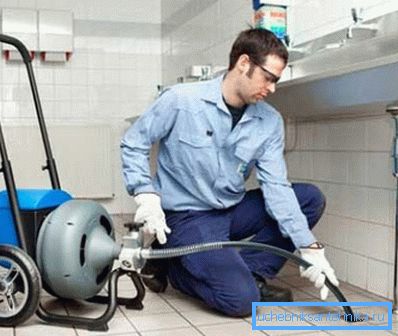
Why clean up
Cleaning of sewer pipes is perceived by many exclusively as a means of eliminating blockages.
However, even a functioning system should be periodically subjected to preventive treatment:
- First, we will increase its throughput.. Sewage water will be removed faster without poisoning the air with unpleasant odors.
- Second, the fluid will not stagnate in the pipes., consequently, the risk of leakage will decrease and the corrosion rate will decrease.
- Finally, with regular cleaning, we will extend the life of the entire system..

If the trouble has occurred, and the blockage has formed, then all possible means for cleaning the sewage pipes should be applied immediately:
- On the one hand, so we will provide the possibility of using water supply.
- On the other hand, we will save money to pay for repairs, the price of which can be quite considerable.
That is why it is worth almost everyone to master the method of removing pollution. Even if you are not a professional plumber, it’s worth it yourself to cope with simple sewage blockages. And this will help you the next section of this article.
Ways to eliminate blockages
Simple solutions
When reducing the drainage rate or when the pipe is completely blocked, it becomes necessary to restore the efficiency of the sewage system. However, before cleaning the sewer pipes using special means, experts recommend trying simple methods.
Often they demonstrate sufficient effectiveness, and the problem is solved in a few minutes.
- Sometimes the narrowing of the lumen of the waste pipeline is caused by the formation of fatty deposits on the walls. This situation is common in private homes without centralized hot water: saving energy, the owners wash dishes with cold water, which does not contribute to the complete dissolution of fat.
- In this situation, it is quite simple to restore the flow rate of the pipes: it is enough to pour about three liters of hot water into the drain hole, wait about 10 minutes and rinse the pipes thoroughly.
Note! You should not use boiling water for these purposes: overheating can lead to deformation and failure of plastic siphons, sealing rings and other polymer parts, the maximum allowed for most of which is 95 0WITH.
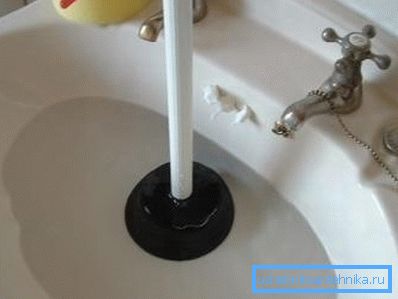
- Another simple tool that helps in cork formation is a plunger. It is used quite simply: close the overflow to avoid pressure loss, install a plunger on the drain and cover the rubber bowl with water. Now you need to pump the pipes several times and then abruptly remove the plunger so that the water is sucked into the rarefied space.
Using these two techniques, you can do away with the hands of most household blockages. However, sometimes such actions are not enough, and radical measures have to be taken.
Use of chemicals
To remove contaminants of an organic nature, the instruction recommends the use of special chemical compounds (Mole, Domestos, Tiret and analogues). Typically, these funds are available either in the form of gels or in the form of granules, and contain concentrated acids or alkalis.
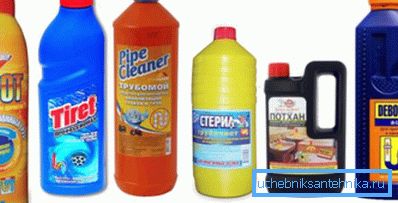
It is necessary to apply these compositions extremely carefully:
- To begin with, we pump the pipes with a plunger to destroy the cork as much as possible.
- Then pour out or pour into the drain the sewer pipe cleaner, strictly observing the dosage.
Tip! Powdered and granular formulations most often need to be poured with a small volume of water, and the liquid used in the finished form.
- We maintain the time indicated on the package. It is very important not to overdo the composition, otherwise there is a risk of damage to the pipeline.
- Thoroughly flush the pipes, removing residual reagent in the sewer.
Even the best tool for cleaning sewer pipes should be used with caution:
- First, concentrated acids and other components of the composition are highly toxic, so you need to work with gloves and a respirator. It is also desirable to provide good ventilation.
- Secondly, it is impossible to combine the compositions and increase their concentration. The result of such experiments is usually the same: a completely or partially destroyed pipeline.
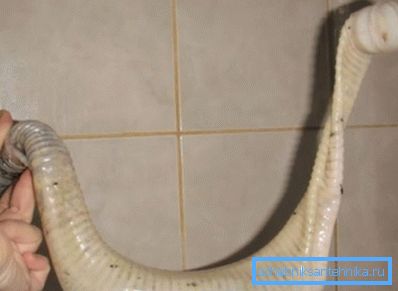
Mechanical methods
If chemical reagents did not help, you will have to take the cork seriously.
Here we need a special device for cleaning sewer pipes:
- Removing a blockage is most easily done with a cable with a spiral nozzle at the end and a handle for rotation.
- This tool is brought into the pipe as close as possible to the place of obstruction, and we promote it until we meet resistance.

Tip! Best of all for this purpose fit auditing hatch, which should be on any sewer pipe.
- Then we begin to rotate the handle, screwing the nozzle into the clog. After some time, we take out the cable by 10-15 cm, hooking on part of the garbage and destroying the dense layer.
- These operations should be repeated several times, periodically removing the cable, closing the inspection pipe and trying to flush the pipe.
Thus, by combining mechanical action and flushing, it is possible in a relatively short time to eliminate even severe pollution from large-sized debris, hairballs, etc.
To facilitate the work, you should also purchase an electric tool for cleaning sewer pipes. The principle of operation is the same as that of the manual model, however, the rotation of the nozzle is carried out using an electric motor or a connected drill.
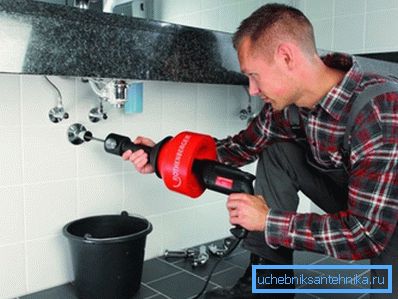
Some models of such tools are designed for professional use, and the power of the motor makes it possible to destroy even very dense blockages up to several tens of centimeters deep.
Use of hydrodynamic systems
However, in some cases, all the above methods do not help, and you have to turn to professionals.
Companies dealing with the elimination of complex blockages, most often use hydrodynamic equipment for cleaning sewer pipes:
- The basis of such a device is a water pump that pumps fluid into the working hoses under considerable pressure.
- At the end of the hose is attached a pointed nozzle with several holes for water supply.
- Like a cable for mechanical cleaning, a hose with a nozzle is inserted into the pipeline through a revision opening and continues until it stops against a barrier.
- Then the nozzle is pressed into the blockage, after which liquid is pumped into it, and multidirectional jets begin, layer by layer, to wash away the accumulated debris.
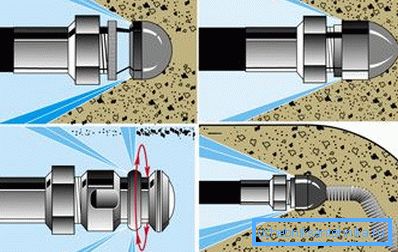
Most often, such installations are used for cleaning highways and storm drains, but you can also use them to eliminate accidents in homes and apartments, as well as for prevention.
Conclusion
Cleaning sewer pipes can be carried out in a variety of situations, ranging from eliminating the effects of blockages and ending with the restoration of cross-country pipelines. The techniques described above will help you cope with almost any problem, especially if you master them at the proper level. And help in this video in this article, containing a large amount of additional information on this topic.